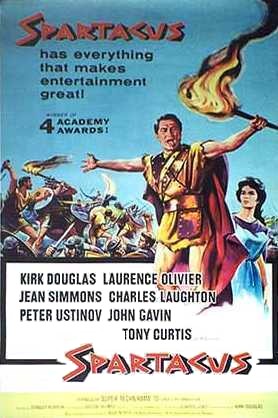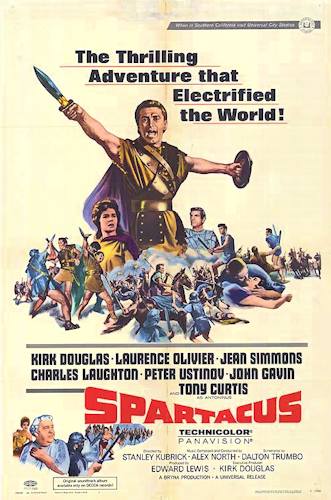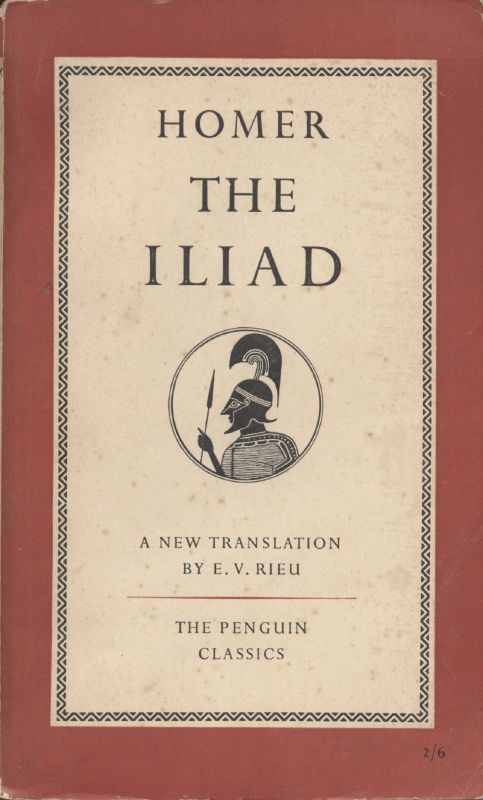Chapter 2: Fidelity in Hollywood: The importance of accuracy when adapting ancient sources into films
Benjamin Parry
Illustrated essay

Perhaps more than any other film practices, cinematic adaptations have drawn the attention, scorn, and admiration of movie viewers, historians, and scholars since 1985. (Corrigan 2007:29)
If you’ve ever sat down and watched a movie with someone who knows anything about history (or thinks they do), you’re probably already familiar with comments like, ‘Y’know, that’s not really the armour they wore back then’ or ‘Why are they using Ionic columns instead of Doric ones?’ But how important are these kinds of details to an audience who can’t tell the difference? This essay will investigate this topic by analysing the films Spartacus (1960) and Troy (2004) to see how creative decisions can impact the creation of a film and the films’ audience. While watching these films before reading this is not necessary, it will make this Sway easier to understand. Before we start, I’ll clarify a few keywords and phrases that will be used throughout this essay.
Anachronism: An anachronism is when something exists that belongs to a different time period. In cinema, this could range from depictions of Roman legions in armour incorrect for the time period or modern phrases being used in period pieces.
Authenticity versus accuracy: Often these two words get conflated when discussed in relation to history in films. While the definitions are still open to debate, for the purposes of this Sway, authenticity can be seen as the perceived accuracy of a film by an audience, whereas accuracy relates to whether a film is consistent with sources and evidence. In short, authenticity is more subjective, and accuracy is more objective (Saxton 2020:127–128).
The Iliad: An epic poem from ancient Greece that takes place towards the end of the Trojan War. It deals with Achilles’ refusal to fight after being offended by the leader of the Greeks, Agamemnon.
The Third Servile War: A war started by gladiators who rebelled against their owners in ancient Rome (73–71 BCE). They freed other slaves and eventually had an army big enough to threaten Rome itself. They were later defeated by the Roman leaders Crassus and Pompey.
Spartacus: Spartacus was one of the key leaders of the slave army in the Third Servile War. He is believed to be one of the original gladiators who escaped and was recorded as having died during the last major battle of the war (Plutarch, Crassus 11.6–7).
Achilles: Achilles is one of central characters of the Iliad and Troy (2004). He was a demigod known for his battle prowess and was said to have been invincible.
Primary and secondary sources: Primary sources are firsthand sources of information from the past, usually from the time of the period being studied or adapted. An example could be Plutarch’s writings about the Third Servile War. Secondary sources are modern writings and analysis about topics, like a book published in 2023 about the Third Servile War.
Now that that’s out of the way, what is the actual issue here?
Should a film be completely accurate to primary sources, and if not, is there a limit to what creative liberties can be granted to filmmakers?
It can help to imagine what the extremes of both sides could be when trying to understand the importance of these topics. If a film about Spartacus and the Third Servile War were to be completely accurate to the sources we still have today, it would probably be 30 minutes to an hour long with next to no dialogue, as the primary sources don’t record any speeches given or words said by Spartacus (Plutarch, Crassus 11.1–8). Additionally, the dialogue that could be heard wouldn’t even be in English! On the other hand, if a filmmaker made a movie based solely on who they thought Spartacus was and what he did, they would run the risk of perpetuating potentially harmful stereotypes and misinformation. This could in turn cause audiences to develop misconceptions about the historical Spartacus and the past.
What elements can impact the decisions of what to change and what to keep when adapting stories from the ancient past?
The period a film is made in has a large impact on the creative decisions made throughout filming. In the case of films adapting stories from the past, this can affect the depiction of the past and the introduction of modern topical themes to an ancient story, and especially leave the film open to general anachronisms from the time it was created. For example, a film from the 1950s set in Rome would likely feature white marble statues, whereas a movie from 2023 would be more likely (though not guaranteed) to feature painted marble statues. This is because knowledge that Roman marble statues were originally painted only became mainstream in the last few decades. You can read more about this in The myth of whiteness in Classical sculpture (Talbot 2018).
The original genre of the story being adapted is another important factor. If an ancient story is fictional, then often a movie remake simply becomes one of many adaptations of the original story. This can often lead to changes within the story without the creation and distribution of misinformation. That said, it is still important to create a sense of authenticity regarding the time the story is set in to prevent the creation of misconceptions and to not ruin the audience’s suspension of belief. This can include depicting time-accurate clothing, armour and behaviours in the adaptation (Gural 2022:2). On the other hand, adaptions of non-fiction stories such as historical events, wars and peoples’ histories are much more prone to spreading misinformation, even propaganda. This is especially the case if a film is advertised as a ‘true story’ or ‘history’. For example, historical films in the past have, intentionally and unintentionally, promoted fascism (Winkler 2017:250). This makes accuracy much more important in film adaptations of historical events.
Spartacus (1960) vs Troy (2004): How are these films similar? (And how do they differ?)

The reason for choosing Spartacus and Troy is because they have key similarities and differences that will help highlight why certain aspects of a film get changed and the impact this can have on the film and the audience. Below is a short list of these similarities and differences.
The similarities
- Both films depict ancient civilisations that have vastly impacted the world today. This ranges from architecture and political institutions/systems to video games and fashion and often stems from groups trying to connect with a ‘great civilisation’ of the past.
- The setting of both films is during a major war.
- Both films take a number of liberties with how they retell their respective stories. These can be as small as removing minor characters to as big as condensing the timeline of the story from years to a few weeks.
- Both films were made by American film companies that involved people with economic and political goals that influenced how they would retell ancient stories.
The differences
- Both films are set in different cultures/locations, Spartacus in Rome and Troy in ancient Greece.
- Spartacus came out in the 20th century, whereas Troy came out in the 21st century.
- Both films are set in different time periods, Spartacus in the 1st century BCE and Troy in the 13th century BCE.
- Spartacus is an adaptation of a novel set during an actual historical event, the Third Servile War, whereas Troy is (mostly) a retelling of the Iliad, an epic poem.
Though there are numerous other minor similarities and differences, these are the biggest ones that have impacted how the stories of Troy and Spartacus have been adapted into film.

Spartacus (1960): A modern story in an ancient setting
Is Spartacus (1960) accurate according to the sources? Well, for the most part Spartacus is made up of fictionalised scenes. It does have a relatively accurate retelling of the general events of the Third Servile War, such as the slave army’s movements through southern Italy and the crucifixion of the recaptured slaves (Hoffman 2000:66–67). In short, the film generally follows the sources, with many scenes inserted to develop characters and story.
Accuracies
Plutarch said Crassus was dogged in his pursuit of the slave army to further his political aspirations (Hoffman 2000:66). Spartacus depicts an abridged version of the slave army’s military campaign (Hoffman 2000:66–67), and the film depicts the slaves as fighting for their freedom, rather than reformation of the Roman state.
Inaccuracies
Women probably wouldn’t have marched with the army (Hoffman 2000:66). The character of Gracchus is fictional, though resembles a character from an earlier period in Rome. A large number of fictionalised scenes were created, such as those between Spartacus and Varinia, and the ‘I’m Spartacus’ scene.
It is a truism that historical films are always about the time in which they are made and never about the time in which they are set.
– Professor Jeffery Richards (Richards 2008:1)
One major factor that impacts the decisions behind what to include and what to leave out when adapting stories from the past is the intent of the creator, or in other words, why was the film made? This can change based on where the film is made, who makes the film and when the film is made, among other things. To provide a bit of background, Stanley Kubrick’s Spartacus is based on a novel by Howard Fast of the same name. This novel was published at the beginning of the Cold War in 1951, and this is reflected in the story. Howard Fast was an open communist in America at the time and was even arrested for his beliefs. This led him to purposely incorporate Marxist themes into his novel, which would be carried over to a later film adaptation which also was worked on by communists (Wyke 1997:60–63). The setting of the Third Servile War acts as a vessel for the story Fast wanted to tell, rather than an accurate retelling of the events based on the sources available. This is evidenced by the many changes and anachronisms found within the film, such as Spartacus being a third-generation slave and the iconic ‘I’m Spartacus’ scene (Richards 2008:83).
Another thing that can affect creative decisions in a film adaptation is what kind of story it is based on. Spartacus is based on a historical event, with few sources from the time. When adapting historical events rather than fictional historical stories, care needs to be taken to make sure adaptations are made respectfully as well as somewhat accurately, lest they create widespread misconceptions of the past or even get used as propaganda (Winkler 2017:250). An example of a misconception that films can create is people believing Spartacus was crucified, whereas Plutarch recorded that he died in battle (Plutarch, Crassus 11.7).
The sweet spot between what is okay to change and what isn’t is difficult to achieve. Modern filmmakers often strive for authenticity in the movies they create, though there is no strict standard they are held to (Richards 2008:1). This often takes the form of creating sets pieces that appear to be accurate to the period the story is set in. In this way, even if filmmakers take creative liberties with the story, audiences can still come away from the movie having learned a bit more about what life was like at the time the movie is set. Unfortunately, this approach can often lead to filmmakers neglecting the original story they are adapting and instead focusing on creating an accurate setting. This can also make it difficult for audiences to understand what is accurate and what isn’t when viewing historical films, as there is no industry standard for what can and cannot be changed when adapting ancient stories.
Troy (2004): A realistic take on an unrealistic story

In contrast to Spartacus, in which changes were made to make the film more ‘Hollywood,’ in Troy (2004) many changes were made to make the story appear more realistic than the original poem. This included removing the Olympian gods, killing off a number of characters who survived in the myths and removing almost all the mystical aspects of the original poem (Gural 2022). The film does, however, follow most of the storyline of the original poem, though with many alterations throughout, both original to the film and based on other ancient sources. Why were these changes made in Troy? There are a few reasons, but this Sway will focus on the time the film was produced (2004) and the fact the film adapts a (probably) fictional story.
To start, Troy is not a straightforward adaptation of the Iliad. The lead writer, David Benioff (of Game of Thrones fame), said the film was ‘not an adaptation of Homer’ but was based on a variety of different versions of the myths surrounding the Trojan War (Richards 2008:178). While this explains away the differences between the Iliad and Troy, it does not absolve the movie of all its sins. Troy is littered with character deaths that don’t appear in any popular versions of the myth, such as Menelaus being killed by Hector after his duel with Paris and Agamemnon’s death while sacking Troy. Perhaps even worse, the film features numerous blatant errors such as depicting the ‘port of Sparta’, a landlocked city-state. These changes demonstrate a lack of respect for the source material and the time the film is based in.
Troy also came out hot on the heels of Ridley Scott’s incredibly popular Gladiator (2000). The consequence was that Gladiator influenced the production and structure of Troy. This included filming in similar locations and both films opening with battles (Richards 2008:177–178). Additionally, like Spartacus, Troy has echoes of the political environment it was created in. Troy echoes anti-war sentiments that were building in America in the wake of US wars in the Middle East under President George W. Bush. Parallels have been drawn between the bloodthirsty leader of the Greeks, Agamemnon, and Bush, with one example being Agamemnon using the abduction of Helen as an excuse to declare war on Troy, something he was depicted as already planning to do (Weinlich 2015:202; Richards 2008:179).
Can anything be done to make Troy more accurate and authentic without changing the essence of the film? Should anything be done? Well, fixing minor anachronisms such as the wardrobe choices and the ‘port of Sparta’ would detract nothing from the film while giving it more historical accuracy. This could prevent the development of possibly incorrect or harmful misconceptions in the public’s conscious. However, decisions to add and remove elements of the Iliad have been done in many different mediums throughout history and, as much as it may annoy some classicists, does not pose any major issues to society.
How important is accuracy when adapting the past?
Some level of respect for the original story is important when making films set in ancient times, lest filmmakers create misconceptions, or even propaganda for potentially huge audiences across the world. That said, many films, especially those based on ancient historical events, require that filmmakers take at least some creative liberties, as the recorded stories often do not transfer well directly into the medium of film. So long as filmmakers demonstrate some level of respect for history and the stories they are adapting, then surely some drama can be excused!
This essay has, hopefully, shown why creative liberties and accuracy to primary sources are important aspects of adapting ancient stories into modern films. This includes how adapting an ancient source into a film without making any change would make for an unwatchable movie, as well as how taking too many creative liberties risks misrepresenting the past and creating misconceptions that can sometimes be harmless, but just as easily risks being used to justify completely different narratives (Furze 2020:146).

